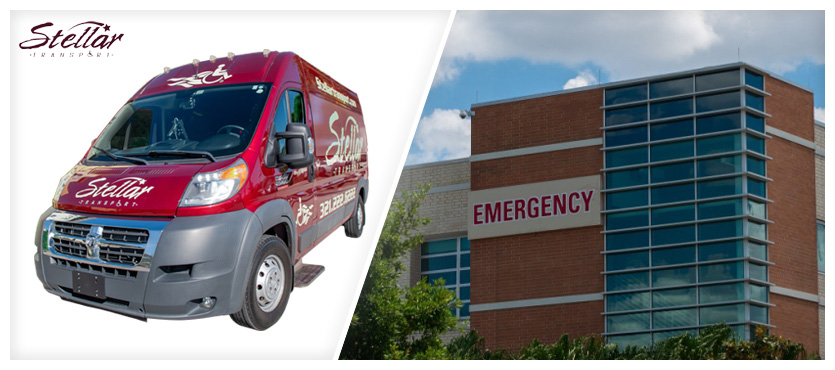Emergency rooms (ERs) are intended to handle life-threatening conditions and acute medical crises. However, across the United States, ERs are frequently overwhelmed by patients seeking care for non-emergency issues—many of which could have been treated more effectively, and more affordably, in a primary care or outpatient setting. One of the underlying causes of this trend is lack of access to reliable transportation.
For individuals without a car, living far from a clinic, or dealing with mobility limitations, the ER may seem like the only accessible option for care. But when patients have dependable, non-emergency transportation options available to them, they’re more likely to receive timely care in the right setting, reducing strain on emergency services and improving overall health outcomes.
Understanding Why Patients Turn to the ER
Emergency rooms often become the default for people who feel they have no other choice. When a patient can’t get to a primary care provider, specialist, or urgent care facility, they may wait until symptoms worsen and then seek help at the ER—whether or not the condition is truly urgent.
This happens frequently among elderly patients, individuals with disabilities, low-income families, and those living in rural or underserved areas. Transportation challenges—such as not owning a vehicle, having no access to public transit, or relying on others for rides—can delay or prevent visits to non-emergency care providers. In the absence of accessible transportation, even minor health issues can escalate into emergencies, or at least appear serious enough to justify an ER visit.
For many, the emergency room is open, available, and doesn’t require an appointment. It becomes the most predictable way to receive care, even if it results in long wait times, higher costs, and fragmented treatment.
The Financial and Medical Impacts of ER Overuse
Using the ER for non-emergency care carries significant consequences. Emergency care is far more expensive than regular office visits or urgent care services. When patients seek care in the ER for non-critical issues, it drives up healthcare costs for individuals, insurance providers, and the healthcare system as a whole.
More importantly, it leads to overcrowded emergency departments, longer wait times, and reduced availability of resources for true emergencies. Patients who legitimately need life-saving care may face delays because resources are being used for preventable or non-urgent visits.
Additionally, ERs are not equipped to provide ongoing, coordinated care. Patients who rely on the ER for health issues often miss out on preventive screenings, chronic disease management, and follow-up care. This results in poor long-term outcomes and a cycle of reactive rather than proactive healthcare.
How Transportation Improves Access to the Right Care
When reliable transportation is available, patients are far more likely to engage with their primary care physicians, specialists, and community clinics. This leads to earlier detection of health issues, better management of chronic conditions, and more effective treatment overall.
Non-Emergency Medical Transportation (NEMT) is specifically designed to fill this gap. It offers patients who cannot drive—due to age, disability, or medical condition—a dependable and safe way to attend routine appointments, physical therapy, mental health visits, and more. This consistency helps prevent the kind of acute flare-ups that often result in ER visits.
For example, a patient with diabetes who receives regular monitoring and care via NEMT is less likely to end up in the ER with complications from uncontrolled blood sugar. A patient managing hypertension can avoid stroke risk through consistent care. And someone with mobility issues who sees their primary care doctor regularly is more likely to catch and treat conditions before they become emergencies.
Who Benefits the Most from NEMT Services
NEMT services make the biggest impact for vulnerable populations—those who are statistically more likely to overuse emergency care due to lack of access. This includes seniors, individuals with chronic illnesses, people with disabilities, Medicaid recipients, and residents of rural areas.
For these individuals, even a short trip to a doctor’s office can become an insurmountable challenge without transportation. NEMT ensures they don’t have to choose between putting off care or going to the emergency room as a last resort.
By supporting early intervention and preventive care, transportation services directly contribute to better health outcomes and reduced dependence on emergency departments.
A Smarter, More Sustainable Healthcare System
Reducing unnecessary ER visits isn’t just good for patients—it’s essential for the healthcare system. When transportation barriers are addressed, hospitals can operate more efficiently, emergency rooms can focus on true emergencies, and the overall cost of care decreases.
Patients who access care consistently through scheduled visits have better continuity of care, stronger provider relationships, and greater health literacy. Transportation helps make this possible by eliminating a major obstacle that keeps people from getting help when they need it—before it becomes an emergency.
Moving Toward Better Health Access
Emergency rooms will always be a critical part of the healthcare system, but they should not be the only option for those who simply need routine care. Reliable transportation, especially through Non-Emergency Medical Transportation services, gives patients the ability to receive appropriate, timely care in non-emergency settings—improving outcomes and reducing pressure on ERs.
Stellar Transport is proud to help reduce unnecessary emergency visits by providing safe, professional, and accessible transportation across Florida. To learn more about how we’re supporting better healthcare access every day, please contact us.

